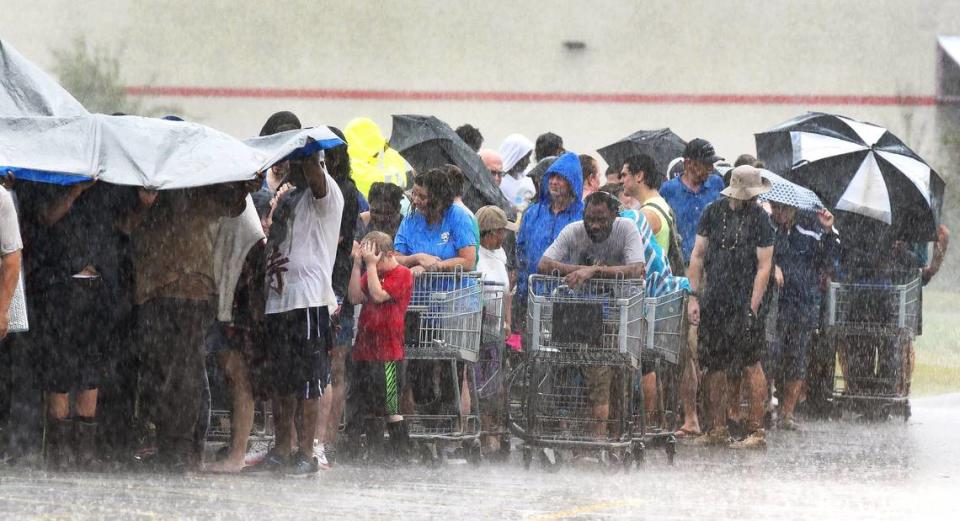As hurricane season approaches in North Carolina, it’s important to be prepared.
Forecasters predict an intense hurricane season for 2024, with an increased chance of major hurricanes making landfall in the Caribbean, the Gulf of Mexico and along the East Coast. That means North Carolina residents are urged to take precautions before a storm hits, including packing an emergency bag, stocking up on non-perishable food and securing their belongings to prevent damage.
This collection of stories provides information on understanding the different categories of hurricanes, putting together emergency kits, getting flood insurance, driving in floodwaters, and preparing for possible evacuations and the safety of your pets.
Hurricane forecasters predict an intense Atlantic season for 2024, with a higher chance of major storms
Forecasters predict an intense hurricane season for 2024, with an increased chance of major hurricanes making landfall in the Caribbean, the Gulf of Mexico and along the East Coast. NOAA and the NC Climate Office agree that the strong El Niño will give way to a La Niña, which typically increases the number of hurricanes in the Atlantic Ocean and can create stronger storms. Read on to learn more about what this could mean for North Carolina and the East Coast.
— Read the full story from N&O reporter Martha Quillin
Prepare for Hurricane Season in North Carolina: 5 Essential Steps to Take
As hurricane season begins, it’s important to be prepared for the worst. North Carolina residents are urged to take precautions before a storm hits. Use this information to prepare for a hurricane, such as packing an emergency bag, stocking up on non-perishable food, and securing your belongings to prevent damage.
— Read the full story from N&O reporter Martha Quillin
A comprehensive guide to preparing for North Carolina’s hurricane season
Once you’ve completed the five steps in the article above, you may want to do more to prepare for hurricane season in North Carolina. From understanding the different categories of hurricanes to creating emergency kits and purchasing flood insurance, this article provides a comprehensive guide to help you stay informed and prepared for the upcoming hurricane season.
— Read the full story from N&O reporter Korie Dean
La Niña is on the horizon and likely to boost hurricane activity in the Atlantic Ocean in 2024
Prepare for a potentially busy Atlantic hurricane season as the strong El Niño fades and gives way to a possible La Niña. La Niña could lead to drier and warmer conditions in the Deep South and an increase in the number and intensity of hurricanes in the Atlantic Ocean. Read more about the prediction and possible consequences in this article.
— Read the full story from N&O reporter Martha Quillin

When a storm hits, check out these live webcams on the North Carolina coast to see wave heights and wind action
Live webcams along the North Carolina coast provide a glimpse into the power of nature during bad weather, and picturesque views of the beach when the sea has calmed. From the northern Outer Banks to the South Coast, these webcams offer clear images and different angles, including one with sound.
— Read the full story from N&O reporter Martha Quillin
Researchers are proposing a new hurricane category – Category 6 – to represent the storm threat caused by climate change
As hurricanes become more frequent and intense due to climate change, researchers suggest the National Hurricane Center should add a Category 6 to the Saffir-Simpson scale. The magnitude, which currently exceeds Category 5, underestimates the true threat from much more powerful storms, they say. The proposed Category 6 would include any storm with sustained winds of more than 200 mph, which several storms have already achieved, and more are likely to come as the planet warms.
— Read the full story from N&O reporter Martha Quillin
How to prepare now to ensure your pets are safe if a hurricane hits
As hurricane season begins, it is crucial to ensure that your preparations include plans for the safety of your pets. From making emergency kits to finding pet-friendly shelters, there are important steps you can take to protect your furry companions during a storm.
— Read the full story from N&O reporter Korie Dean


Before a storm hits, make sure you understand the NC evacuation zones
During hurricane season it is important to be prepared for possible evacuations. North Carolina has established predetermined evacuation zones in 20 eastern counties, and local officials are responsible for ordering evacuations. Evacuations can be voluntary or mandatory, and it is critical to follow designated evacuation routes to ensure safety.
This article provides information on how evacuations are ordered, the difference between voluntary and mandatory evacuations, how to find your evacuation zone, and what to do if you are ordered to evacuate. It also includes tips for evacuating with pets and general information about hurricanes.
— Read the full story from N&O reporter Korie Dean
Turn around, don’t drown: Here are the best guidelines for preparing for and staying safe in floodwaters
North Carolina residents should be prepared for the threat of flooding during storms that bring heavy rain. While high winds can make headlines, it’s important to remember that flooding often causes more damage. In this guide, we explore how to prepare for a flood, how to stay safe in floods, and how to consider flood insurance options.
— Read the full story from N&O reporter Kimberly Cataudella Tutuska
How to Assess Storm Damage and File Insurance Claims in North Carolina After a Storm
Severe storms can often cause damage to our homes and property. This article provides tips on assessing damage, planning repairs, and filing insurance claims after a hurricane or other natural disaster. From following directions and avoiding flooding to removing debris and ensuring drinking water safety, these practical steps will help you stay safe and protect your property.
— Read the full story from N&O reporter Korie Dean
This page is a collection of stories reported and written by McClatchy journalists. The collection was compiled using an AI summary tool and edited by newsroom journalists. Read more about our AI policy here.






